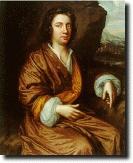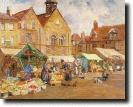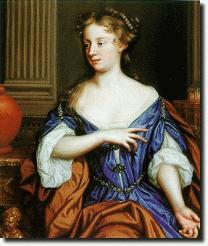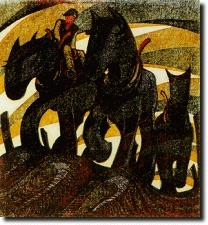 | |
|
(Below): Charles Beale, by Mary Beale, c. 1665.  (Below): Abbeygate Street, watercolour, by Rose Mead, c. 1920.  (Below): Butter Market and Moyse's Hall, by Rose Mead, 1927.  (Below): Tumulus, colour linocut, by Sybil Andrews, 1936. 
|
Mary Beale (1633-99) One of the most important local artists represented in the collection is Mary Beale. Born the daughter of John Cradock, Rector of Barrow, near Bury St. Edmunds, she married a distant cousin, Charles Beale, and moved to London. She had already received training as an artist, and with additional advice from Sir Peter Lely and other notable practitioners of the period, she set up her own studio. It was very unusual for a woman to take up a professional career as an artist at this time, but Mary Beale soon built up a considerable clientele, especially among the new breed of leading Puritans. Indeed, she became so successful that her husband chose to abandon his own career in order to act as her assistant and secretary.  (Above): Self portrait, by Mary Beale, c. 1675. Although she was highly rated by her contemporaries, and described by the eighteenth-century art historian George Vertue as 'little inferior to any of her [male] contemporaries either for colouring, strength, force or life', her work was later unfavourably compared with her more illustrious male contemporaries; only recently has it been reassessed and given the recognition it deserves. Notable examples of her work in this collection include a portrait of her husband, painted around 1665; the wistful, haunting face of Sarah Hall, c. 1680, and one of the best of the artist's self-portraits c. 1675, painted on sacking because artist's canvas was expensive and so used chiefly for official portrait commissions. Rose Mead (1867-1946) Rose Mead, the daughter of a local builder, studied at Lincoln Art College, the Westminster School in London and in a private studio in Paris. She exhibited some early works in the Royal Academy, but by around 1905 had returned to Bury St. Edmunds where she spent the rest of her life. Having established a studio in Crown Street, she made a living from painting portraits, local views, interiors and still-lifes. Her attractive technique is characterized by loose brush strokes, sombre and bright tones effectively combined, and highlighted with touches of thickly-layered paint, or impasto. Keen on painting girls and young women, Rose Mead would often approach one that attracted her attention in the street and request a sitting; for this the girl would be paid about sixpence to one shilling an hour.  (Above): Barbara Stone, by Rose Mead, c. 1930 The museum has a good representative collection of her work. One of the most popular portraits is that of her elderly housekeeper Barbara Stone, peeling apples at the kitchen table. Rose Mead was particularly talented at portraying characters and this is a fine example of a character she knew well. The artist's keen affection for her home town is represented by the lively painting of the Butter Market and Moyse's Hall 1927 Sybil Andrews (1898-1992) Sybil Andrews had a very distinctive approach although her early watercolours record the same Picturesque buildings in the town which Rose Mead also loved to paint. In 1925 she moved to London where she studied at the newly established Grosvenor School of Modern Art. Under her tutor, the avant-garde artist Claude Flight, she began to experiment with printing techniques. The result was a series of highly individual colour linocuts which today have given her an international reputation.  (Above): Day's End, colour linocut, by Sybil Andrews, 1961. Hand-printed on Japanese tissue paper the dynamic, angular compositions are built-up from three or four basic colours which are overprinted to create a much greater variety of tone. For some time, Sybil Andrews had been striving towards greater economy of form and she describes how for her, the lino block process was 'the greatest teacher of all . . .you are forced to simplify your idea to its fundamentals.' Many of the linocuts reflect the machine age and urban life, but others are of rural life inspired by the artist's early years in Suffolk. She continued to produce these even after emigrating to Canada in 1947. Typical examples are Michaelmas (1935), Ploughing Pasture (1954), and Day's End (1961) In recent years Sybil Andrews very generously donated a substantial collection of her works to the museum, including early watercolours of Bury St. Edmunds. |
